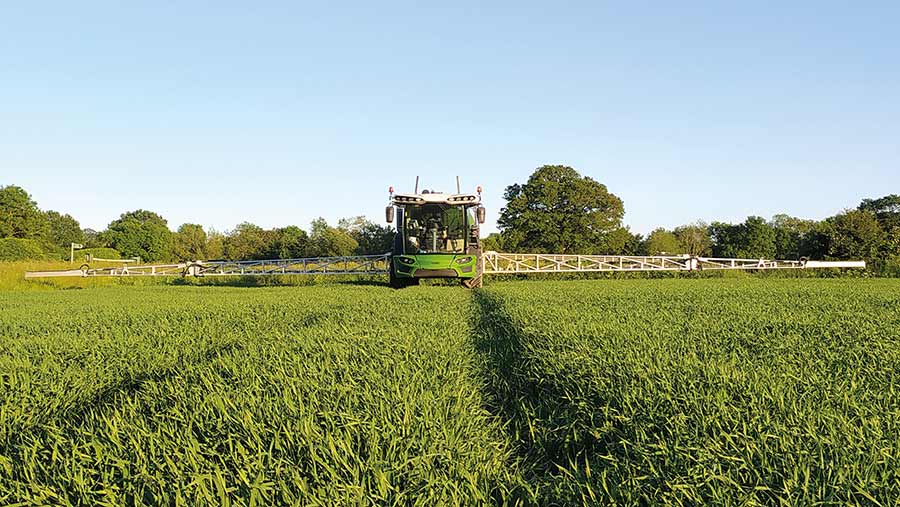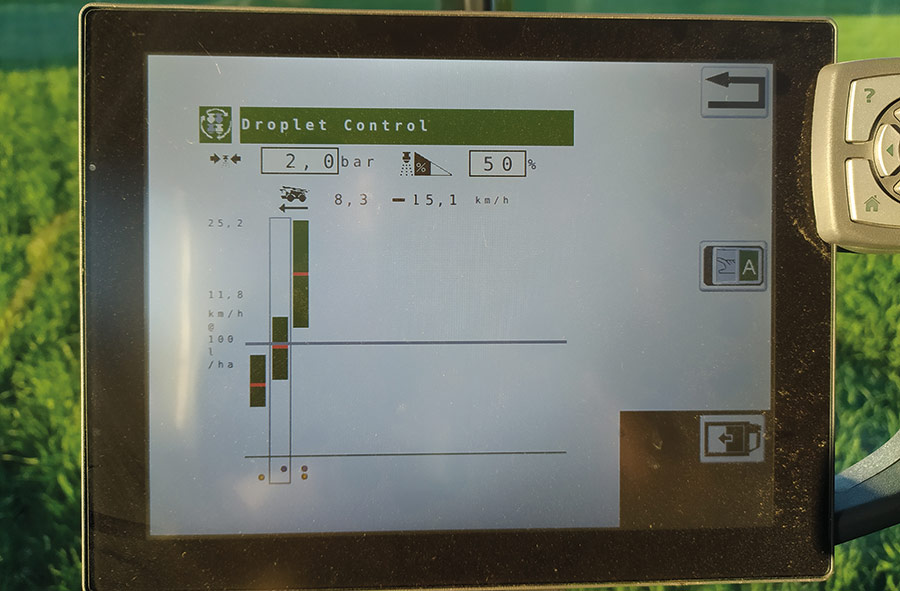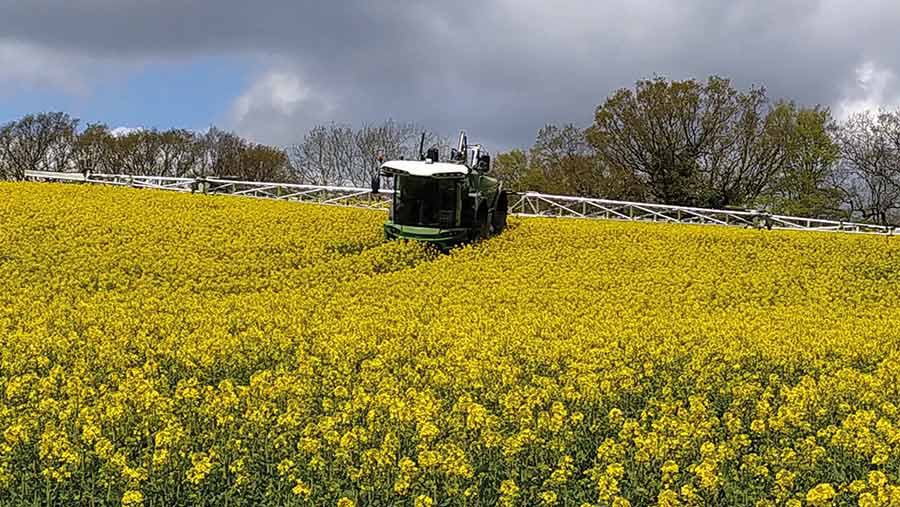Driver’s view: Luke Haynes’ Fendt Rogator 645
This is Luke Haynes’ second consecutive year as a Farm Sprayer Operator of the Year finalist, having narrowly missing out in 2020. Since our visit a year ago, he has changed farms and now drives a Fendt Rogator 645.
Farm facts
- Operator Luke Haynes
- Company Stevens Farm, Hawkhurst, Kent
- Farm size 1,150ha, Weald clay to Tunbridge sand
- Crops grown Wheat, oilseed rape, beans, oats
- Sprayer used Fendt Rogator 645

Luke Haynes covered over 600ha in six days with the Rogator earlier this year © Luke Haynes
What sprayer are you using?
I moved to Stevens Farm in February this year and that meant switching from the Bateman RB35 I used to drive to a Fendt Rogator 645. I’ve clocked about 400hours on it in that time.
This machine is the third Rogator the farm has owned. First was an A-series, followed by a newer C-series, which was replaced by the 645 in 2019. I’m told the farm looked at a Horsch, but ultimately it came down to sticking with what they knew.
The package included an eight-year warranty, so I reckon we’ll be hanging onto it for a few years yet. When the time comes to trade it in, it will probably have plenty of hours on the clock, as we average 1,000/year.
See also: Driver’s view: Luke Haynes’ Bateman RB35 sprayer
What extras did you get?
Being a Fendt, there was a stack of options, but the best one we have is the Arag quad nozzle bodies. Combined with Fendt’s Optinozzle technology, it can switch between the four nozzles on the go.
I set the parameters for different nozzles in the screen and the rate I want to spray at, and the machine will determine which nozzle is best suited to the speed I’m travelling. It is all designed to keep droplet size and coverage as uniform as possible over the field, and does the job really well.

Fendt’s automatic system can switch between up to four nozzles to maintain droplet size © Luke Haynes
For instance, on a headland, it will select a smaller orifice nozzle as my forward speed tends to be slower when I’m close to a hedge. Comparatively, when romping up and down the middle of a field it selects a bigger set.
The changes are instant and barely noticeable, and I have the option to choose how many of the nozzles it can switch between. I’ve done paper tests to check the pattern, and it’s near perfect.
One of the biggest improvements over the Bateman I used to drive is the application technology. The individual nozzle control means overlaps are now tiny, whereas before I’d notice if a section of crop caught a double dose of plant growth regulator. Those chemical savings soon begin to add up.
Everything is very intuitive and, as with the Fendt tractors, it doesn’t take long for it all to make sense. Last year, I said the Bateman had a comfortable cab, and I stand by that. However, the Fendt is on another level.
There’s a lot of crossover with the tractors in terms of switchgear and screens, but it means it is familiar and easy to use. The visibility from the seat is a real standout.
The TMS system makes the hydrostatic act like Vario, so there is no need to have the engine running flat out when travelling on the road. Suspension is good too, and I’m able to jack up to 1.2m ground clearance when spraying tall oilseed rape crops.
The other benefit of this setup is during filling – it self-levels as the liquid volume increases to keep the machine sitting true.
The Challenger models used to run Norac’s automatic boom levelling system, but this is the first sprayer we’ve had since Fendt added its own setup. I use it nearly all the time, but it needs to be watched as it only has two sensors on each side, so patchy crops can cause it to dive down on one wing if I’m not careful.
As for filling, there’s an auto setting, which beeps at me 50 litres from full to switch the water off. The massive 60-litre induction bowl is big enough to sit in, but the best bit is being able to vary the speed of the 785 litres/min pump in five stages – for bigger mixes, I can have it sucking the water in slowly so that I don’t have to rush.
How has it performed?
We’ve had a few issues recently but, when it’s working, I’d argue that there isn’t a better machine out there. The backup from Crawfords has been excellent, though I’ve got to know their sprayer man, Sean Burgess, a bit better than I’d like.
Our biggest problem has been niggling electrical issues – individual sensors and switches throwing up faults – that have held me up. I won’t say too much as Agco is now helping us through the problem, but it has meant we have been without the sprayer for a few good days this spring.
At one point, I had to calibrate the brake pedal more than 20 times in a single day, which takes 10mins a time.
However, I can seriously cover the ground when all is well. After the recent rain, I put in some long hours and managed to do over 600ha in under six days. Our land is spread from Ashford to Tunbridge Wells – a 30-mile jaunt – so, while we try and plan work to avoid too much travelling, it’s easy to lose a lot of time on the road.
We’ve changed from running two sets of tyres on the previous Rogator to just one set now – Michelin Omnibib 620/80 R42s. The taller wheel offers a better turning circle, down to around 3m internally, which is tighter than the Bateman I used to drive.
I can also run at a lower pressure all year, which helps spread the weight and we haven’t noticed a huge difference in the crop as a result of the wider tramlines.
This saves time changing wheels, plus the obvious cost of buying them in the first place. All the ground has been in a no-till system for over eight years, so it travels well in the wet and retains moisture when it’s dry.

The sprayer only has one set of wheels, which has saved money and time with little impact on the crop © Luke Haynes
What are your go-to nozzles?
With Fendt’s Optinozzle system, I can have four different nozzles in play at once, leaving the machine to switch through them according to my forward speed. Hypro Defy 3Ds are my go-to for herbicide applications.
I’d never used Albuz nozzles before I started this job, but I’ve been quite impressed with them. I run the ABI version for fungicide treatments and then Albuz ABI twins, which is the same nozzle but with a twin outlet, for ear washes.
Fungicides tend to go on at 100 litres/ha and herbicides at 200 litres/ha, usually at speeds of 12-16kph.
What’s your spray store and fill-up area like?
Currently, our spray store is a lorry container but soon we’ll be moving to something much smarter. It will have a purpose-built insulated and bunded chemical store, a decent filling area and a bio bed.
Given our geographical spread, we’ve got a number of satellite filling areas on different farms to reduce the amount of travelling required.
We are also looking into bowser options to try and reduce the amount of time the sprayer spends on the road. One thing I’d like to see is Fendt make a closed transfer system compatible with the Rogator. It’s something I’ve been looking at for a while, but nothing works with this sprayer yet.
Fendt Rogator 645 stats
- Price paid £250,000
- Year 2020
- Hours 800
- Engine 7.4-litre, six-cylinder Agco Power
- Power 245hp
- Transmission Bosch Rexroth hydrostatic
- Road speed 50kph
- Tank size 5,000 litres
- Rinse tank 500 litres
- Nozzles Quad bodies
- Auto shut-off Individual nozzle
- Boom levelling Fendt
- Guidance Trimble RTK
- Boom width 30m
- Wheel sizes Michelin Omnibib 620/80 R42
Likes and gripes
Likes
✅ Droplet consistency with Optinozzle
✅ Individual nozzle control
✅ Supreme cab and ride
Gripes
❌ Continuing electrical niggles
❌ No closed transfer system integration
❌ Must be dealer serviced

